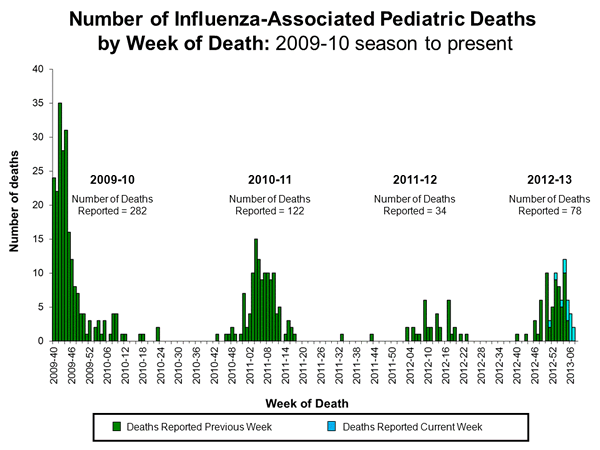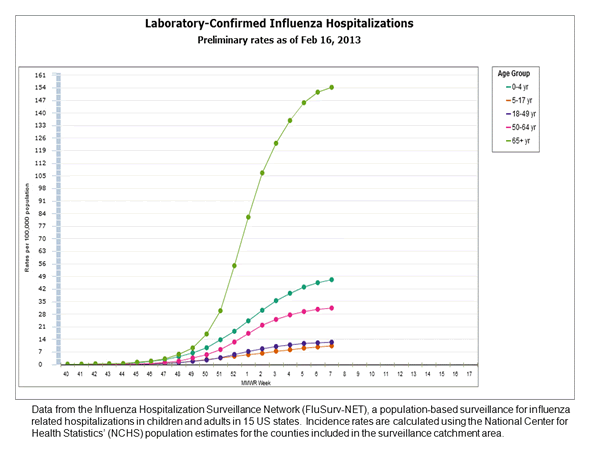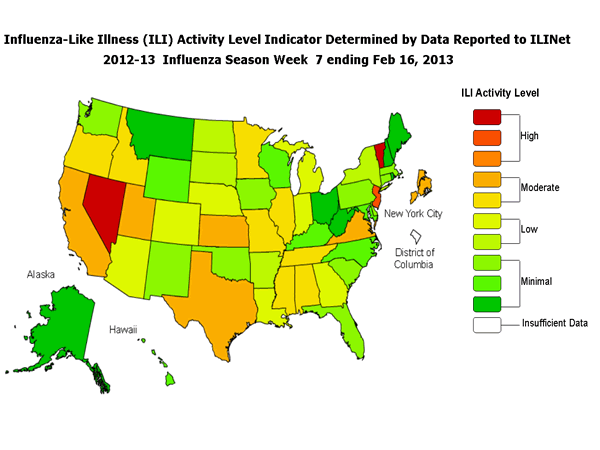Error processing SSI file

2012-2013 Influenza Season Week 7 ending February 16, 2013
All data are preliminary and may change as more reports are received.
Synopsis:
During week 7 (February 10 - 16, 2013), influenza activity remained elevated in the United States, but decreased in most areas.
- Viral Surveillance: Of 8,144 specimens tested and reported by collaborating laboratories, 1,371 (16.8%) were positive for influenza.
- Pneumonia and Influenza Mortality: The proportion of deaths attributed to pneumonia and influenza (P&I) was above the epidemic threshold.
- Influenza-Associated Pediatric Deaths: Fourteen pediatric deaths were reported.
- Influenza-Associated Hospitalizations: A cumulative rate for the season of 34.2 laboratory-confirmed influenza-associated hospitalizations per 100,000 population was reported. Of reported hospitalizations, more than 50% were among adults 65 years and older.
- Outpatient Illness Surveillance: The proportion of outpatient visits for influenza-like illness (ILI) was 2.8%. This is above the national baseline of 2.2%. All 10 regions reported ILI at or above region-specific baseline levels. Three states experienced high ILI activity; 13 states and New York City experienced moderate activity; 11 states experienced low activity; 23 states experienced minimal activity, and the District of Columbia had insufficient data.
- Geographic Spread of Influenza: Twenty-two states reported widespread influenza activity; Puerto Rico and 21 states reported regional influenza activity; the District of Columbia and 6 states reported local influenza activity; 1 state reported sporadic influenza activity; Guam reported no influenza activity, and the U.S. Virgin Islands did not report.
A description of surveillance methods is available at: http://www.cy118119.com/flu/weekly/overview.htm
| HHS Surveillance Regions* | Data for current week | Data cumulative since September 30, 2012 (Week 40) | ||||||||
|---|---|---|---|---|---|---|---|---|---|---|
| Out-patient ILI† | % positive for flu‡ | Number of jurisdictions reporting regional or widespread activity§ | 2009 H1N1 | A (H3) | A(Subtyping not performed) | B | Pediatric Deaths | |||
| Nation | Elevated | 16.8% | 44 of 54 | 925 | 30,124 | 14,769 | 12,489 | 78 | ||
| Region 1 | Elevated | 19.5% | 5 of 6 | 53 | 2,304 | 579 | 195 | 3 | ||
| Region 2 | Elevated | 19.2% | 3 of 4 | 142 | 2,244 | 2,026 | 620 | 12 | ||
| Region 3 | Elevated | 25.9% | 4 of 6 | 181 | 6,485 | 456 | 1,042 | 2 | ||
| Region 4 | Elevated | 20.3% | 4 of 8 | 69 | 2,399 | 5,764 | 2,058 | 9 | ||
| Region 5 | Elevated | 29.1% | 6 of 6 | 78 | 4,627 | 460 | 883 | 19 | ||
| Region 6 | Elevated | 25.2% | 5 of 5 | 53 | 1,962 | 2,746 | 3,243 | 18 | ||
| Region 7 | Elevated | 20.0% | 4 of 4 | 25 | 1,878 | 180 | 835 | 3 | ||
| Region 8 | Elevated | 19.5% | 6 of 6 | 133 | 2,667 | 1,711 | 2,499 | 7 | ||
| Region 9 | Elevated | 30.8% | 3 of 5 | 154 | 3,118 | 625 | 743 | 4 | ||
| Region 10 | Elevated | 19.9% | 4 of 4 | 37 | 2,440 | 222 | 371 | 1 | ||
*HHS regions (Region 1 CT, ME, MA, NH, RI, VT; Region 2: NJ, NY, Puerto Rico, US Virgin Islands; Region 3: DE, DC, MD, PA, VA, WV; Region 4: AL, FL, GA, KY, MS, NC, SC, TN; Region 5: IL, IN, MI, MN, OH, WI; Region 6: AR, LA, NM, OK, TX; Region 7: IA, KS, MO, NE; Region 8: CO, MT, ND, SD, UT, WY; Region 9: AZ, CA, Guam, HI, NV; and Region 10: AK, ID, OR, WA).
† Elevated means the % of visits for ILI is at or above the national or region-specific baseline
‡ National data are for current week; regional data are for the most recent three weeks
§ Includes all 50 states, the District of Columbia, Guam, Puerto Rico, and U.S. Virgin Islands
U.S. Virologic Surveillance:
U.S. World Health Organization (WHO) and National Respiratory and Enteric Virus Surveillance System (NREVSS) collaborating laboratories located in all 50 states and Puerto Rico report to CDC the number of respiratory specimens tested for influenza and the number positive by influenza virus type and influenza A virus subtype. Region specific data can be found at http://gis.cdc.gov/grasp/fluview/fluportaldashboard.html.
| Week 7 | |
|---|---|
| No. of specimens tested | 8,144 |
| No. of positive specimens (%) | 1,371 (16.8%) |
| Positive specimens by type/subtype | |
| Influenza A | 752 (54.9%) |
| 2009 H1N1 | 32 (4.3%) |
| Subtyping not performed | 392 (52.1%) |
| H3 | 328 (43.6%) |
| Influenza B | 619 (45.1%) |
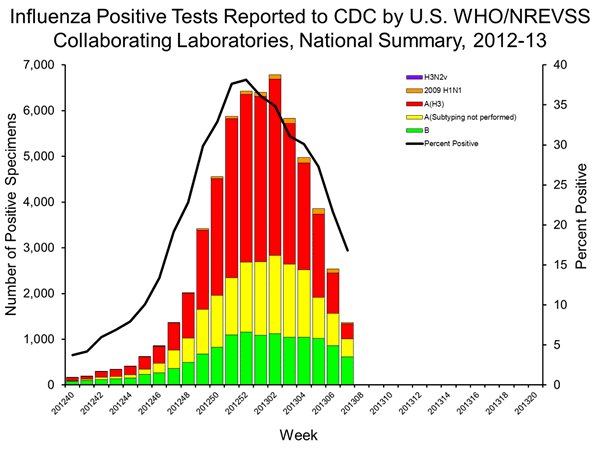
View National and Regional Level Graphs and Data | View Chart Data | View Full Screen | View PowerPoint Presentation
Since the start of the season, influenza A (H3N2) viruses have predominated nationally, followed by influenza B viruses, while 2009 H1N1 viruses have been identified less frequently. Over the course of the season the predominant circulating virus has varied by state and by region.
Antigenic Characterization:
CDC has antigenically characterized 1,185 influenza viruses [86 2009 H1N1 viruses, 744 influenza A (H3N2) viruses, and 355 influenza B viruses] collected by U.S. laboratories since October 1, 2012.
2009 H1N1 [86]:
- All 86 2009 H1N1 viruses tested were characterized as A/California/7/2009-like, the influenza A (H1N1) component of the 2012-2013 influenza vaccine for the Northern Hemisphere.
Influenza A (H3N2) [774]:
- 740 (99.5%) of the 744 H3N2 influenza viruses tested have been characterized as A/Victoria/361/2011-like, the influenza A (H3N2) component of the 2012-2013 Northern Hemisphere influenza vaccine.
- 4 (0.5%) of the 744 H3N2 viruses tested showed reduced titers with antiserum produced against A/Victoria/361/2011.
Influenza B (B/Yamagata/16/88 and B/Victoria/02/87 lineages) [355]:
- Yamagata Lineage [251]: 251 (70.7%) of the 355 influenza B viruses tested so far this season have been characterized as B/Wisconsin/1/2010-like, the influenza B component of the 2012-2013 Northern Hemisphere influenza vaccine.
- Victoria Lineage [104]: 104 (29.3%) of 355 influenza B viruses tested have been from the B/Victoria lineage of viruses.
Antiviral Resistance:
Testing of 2009 H1N1, influenza A (H3N2), and influenza B virus isolates for resistance to neuraminidase inhibitors (oseltamivir and zanamivir) is performed at CDC using a functional assay. Additional 2009 influenza A (H1N1) clinical samples are tested for a single mutation in the neuraminidase of the virus known to confer oseltamivir resistance (H275Y). The data summarized below combine the results of both testing methods. These samples are routinely obtained for surveillance purposes rather than for diagnostic testing of patients suspected to be infected with antiviral-resistant virus.
High levels of resistance to the adamantanes (amantadine and rimantadine) persist among 2009 influenza A (H1N1) and A (H3N2) viruses (the adamantanes are not effective against influenza B viruses). As a result, data from adamantane resistance testing are not presented below.
| Oseltamivir | Zanamivir | |||
|---|---|---|---|---|
| Virus Samples tested (n) | Resistant Viruses, Number (%) | Virus Samples tested (n) | Resistant Viruses, Number (%) | |
| Influenza A (H3N2) | 1,193* | 0 (0.0) | 1,193* | 0 (0.0) |
| Influenza B | 419 | 0 (0.0) | 419 | 0 (0.0) |
| 2009 H1N1 | 274* | 2 (0.9) | 114 | 0 (0.0) |
*Includes specimens tested in national surveillance and additional specimens tested at public health laboratories in 10 states (AZ, DE, HI, ME, MD, MI, MN, NY, PA, and, WI) who share testing results with CDC.
The majority of currently circulating influenza viruses are susceptible to the neuraminidase inhibitor antiviral medications oseltamivir and zanamivir; however, rare sporadic cases of oseltamivir-resistant 2009 H1N1 and A (H3N2) viruses have been detected worldwide. Antiviral treatment with oseltamivir or zanamivir as early as possible is recommended for patients with confirmed or suspected influenza who have severe, complicated, or progressive illness; who require hospitalization; or who are at greater risk for serious influenza-related complications. Additional information on recommendations for treatment and chemoprophylaxis of influenza virus infection with antiviral agents is available at http://www.cy118119.com/flu/antivirals/index.htm.
Novel Influenza A Virus:
No new human infections with novel influenza A viruses were reported to CDC during week 7.
A total of 312 infections with variant influenza viruses (308 H3N2v viruses, 3 H1N2v viruses, and 1 H1N1v virus) have been reported from 11 states since July 2012. More information about H3N2v infections can be found at http://www.cy118119.com/flu/swineflu/h3n2v-cases.htm.
Pneumonia and Influenza (P&I) Mortality Surveillance:
During week 7, 8.6% of all deaths reported through the 122 Cities Mortality Reporting System were due to P&I. This percentage was above the epidemic threshold of 7.5% for week 7.

View Full Screen | View PowerPoint Presentation
Influenza-Associated Pediatric Mortality:
Fourteen influenza-associated pediatric deaths were reported to CDC during week 7. Three were associated with influenza A (H3) viruses and occurred during weeks 3, 5, and 6 (weeks ending January 19, February 2, and 9, 2013), two were associated with 2009 H1N1 viruses and occurred during weeks 5 and 6 (weeks ending February 2 and 9, 2013), two were associated with an influenza A virus for which the subtype was not determined and occurred during weeks 4 and 6 (week ending January 26 and February 9, 2013), six were associated with influenza B viruses and occurred during weeks 51, 4, 5, 6, and 7 (weeks ending December 22, 2012, January 26, February 2, February 9, and February 16, 2013), and one was associated with both an influenza A and influenza B virus and occurred during week 1 (week ending January 5, 2013).
A total of 78 influenza-associated pediatric deaths have been reported during the 2012-2013 season from Chicago [1], New York City [3] and 30 states (Arkansas [2], Arizona [2], California [1], Colorado [5], Florida [6], Hawaii [1], Illinois [1], Indiana [3], Kansas [2], Louisiana [1], Maine [1], Maryland [1], Massachusetts [1], Michigan [5], Minnesota [3], Mississippi [1], Nebraska [1], New Hampshire [1], New Jersey [4], New Mexico [2], New York [5], Ohio [4], Pennsylvania [1], South Carolina [1], South Dakota [1], Tennessee [1], Texas [13], Utah [1], Washington [1], and Wisconsin [2]). Additional data can be found at http://gis.cdc.gov/GRASP/Fluview/PedFluDeath.html.
Influenza-Associated Hospitalizations:
The Influenza Hospitalization Surveillance Network (FluSurv-NET) conducts population-based surveillance for laboratory-confirmed influenza-related hospitalizations in children younger than 18 years of age (since the 2003-2004 influenza season) and adults (since the 2005-2006 influenza season).
The FluSurv-NET covers more than 80 counties in the 10 Emerging Infections Program (EIP) states (CA, CO, CT, GA, MD, MN, NM, NY, OR, TN) and additional Influenza Hospitalization Surveillance Project (IHSP) states. The IHSP began during the 2009-2010 season to enhance surveillance during the 2009 H1N1 pandemic. IHSP sites included IA, ID, MI, OK and SD during the 2009-2010 season; ID, MI, OH, OK, RI, and UT during the 2010-2011 season; MI, OH, RI, and UT during the 2011-2012 season; and IA, MI, OH, RI, and UT during the 2012-2013 season.
Data gathered are used to estimate age-specific hospitalization rates on a weekly basis, and describe characteristics of persons hospitalized with severe influenza illness. The rates provided are likely to be an underestimate as influenza-related hospitalizations can be missed, either because testing is not performed, or because cases may be attributed to other causes of pneumonia or other common influenza-related complications.
Between October 1, 2012 and February 16, 2013, 9,531 laboratory-confirmed influenza-associated hospitalizations were reported. This is a rate of 34.2 per 100,000 population. The most affected group is those ≥65 years, accounting for more than 50% of reported cases. Among all hospitalizations, 8,179 (85.8%) were associated with influenza A and 1,278 (13.4%) with influenza B. There was no virus type information for 41 (0.4%) hospitalizations. Among hospitalizations with influenza A subtype information, 2,432 (97.4%) were attributed to H3 and 52 (2.1%) were attributed to 2009 H1N1. The most commonly reported underlying medical conditions among hospitalized adults were cardiovascular disease, metabolic disorders, obesity, and chronic lung disease (excluding asthma). The most commonly reported underlying medical conditions in hospitalized children were asthma, neurologic disorders, and immune suppression. Forty-four percent of hospitalized children had no identified underlying medical conditions. Among 267 hospitalized women of childbearing age (15-44 years), 71 were pregnant, including 3 pregnancies among the 17 pediatric cases in this category. Additional FluSurv-NET data can be found at: http://gis.cdc.gov/GRASP/Fluview/FluHospRates.html and http://gis.cdc.gov/grasp/fluview/FluHospChars.html.
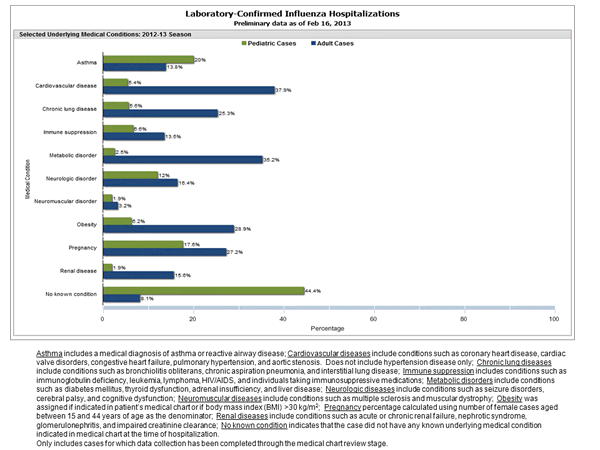
View Interactive Application | View Full Screen | View PowerPoint Presentation
Outpatient Illness Surveillance:
Nationwide during week 7, 2.8% of patient visits reported through the U.S. Outpatient Influenza-like Illness Surveillance Network (ILINet) were due to influenza-like illness (ILI). This percentage is above the national baseline of 2.2%. (ILI is defined as fever (temperature of 100°F [37.8°C] or greater) and cough and/or sore throat.) Region specific data is available at http://gis.cdc.gov/grasp/fluview/fluportaldashboard.html.
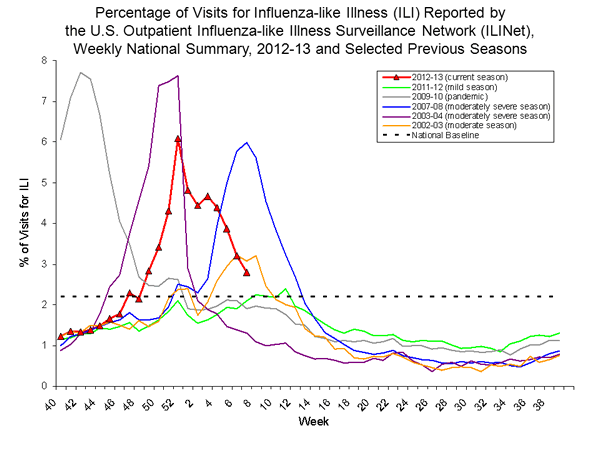
View National and Regional Level Graphs and Data | View
Chart Data | View Full Screen | View PowerPoint Presentation
On a regional level, the percentage of outpatient visits for ILI ranged from 1.8% to 3.8% during week 7. All 10 regions reported a proportion of outpatient visits for ILI at or above their region-specific baseline levels.
ILINet Activity Indicator Map:
Data collected in ILINet are used to produce a measure of ILI activity* by state. Activity levels are based on the percent of outpatient visits in a state due to ILI and are compared to the average percent of ILI visits that occur during spring and fall weeks with little or no influenza virus circulation. Activity levels range from minimal, which would correspond to ILI activity from outpatient clinics being below the average, to high, which would correspond to ILI activity from outpatient clinics being much higher than average.
During week 7, the following ILI activity levels were experienced:
- Three states experienced high ILI activity (Nevada, New Jersey, and Vermont).
- Thirteen states and New York City experienced moderate ILI activity (Alabama, California, Idaho, Illinois, Kansas, Minnesota, Mississippi, Missouri, Oregon, Tennessee, Texas, Utah, and Virginia).
- Eleven states experienced low ILI activity (Arizona, Arkansas, Colorado, Georgia, Indiana, Louisiana, Michigan, Nebraska, New York, North Dakota, and South Dakota).
- Twenty-three states experienced minimal ILI activity (Alaska, Connecticut, Delaware, Florida, Hawaii, Iowa, Kentucky, Maine, Maryland, Massachusetts, Montana, New Hampshire, New Mexico, North Carolina, Ohio, Oklahoma, Pennsylvania, Rhode Island, South Carolina, Washington, West Virginia, Wisconsin, and Wyoming).
- Data were insufficient to calculate an ILI activity level for the District of Columbia.
*This map uses the proportion of outpatient visits to health care providers for influenza-like illness to measure the ILI activity level within a state. It does not, however, measure the extent of geographic spread of flu within a state. Therefore, outbreaks occurring in a single city could cause the state to display high activity levels.
Data collected in ILINet may disproportionately represent certain populations within a state, and therefore, may not accurately depict the full picture of influenza activity for the whole state.
Data displayed in this map are based on data collected in ILINet, whereas the State and Territorial flu activity map are based on reports from state and territorial epidemiologists. The data presented in this map is preliminary and may change as more data is received.
Differences in the data presented here by CDC and independently by some state health departments likely represent differing levels of data completeness with data presented by the state likely being the more complete.
Geographic Spread of Influenza as Assessed by State and Territorial Epidemiologists:
The influenza activity reported by state and territorial epidemiologists indicates geographic spread of influenza viruses, but does not measure the severity of influenza activity.
During week 7, the following influenza activity was reported:
- Widespread influenza activity was reported by 22 states (Alaska, Arizona, Arkansas, California, Colorado, Connecticut, Idaho, Indiana, Iowa, Kansas, Massachusetts, Michigan, New Jersey, New Mexico, New York, Ohio, Oklahoma, Oregon, Pennsylvania, Virginia, Washington, and Wyoming).
- Puerto Rico and 21 states reported regional influenza activity (Florida, Kentucky, Illinois, Louisiana, Maine, Maryland, Minnesota, Missouri, Montana, Nebraska, Nevada, New Hampshire, North Dakota, South Carolina, South Dakota, Tennessee, Texas, Utah, Vermont, West Virginia, and Wisconsin).
- The District of Columbia and 6 states (Alabama, Georgia, Hawaii, Mississippi, North Carolina, and Rhode Island) reported local influenza activity.
- One state (Delaware) reported sporadic influenza activity.
- Guam reported no influenza activity.
- The U.S. Virgin Islands did not report.
- Content Source: Coordinating Center for Infectious Diseases (CCID)
- National Center for Immunization and Respiratory Diseases (NCIRD)
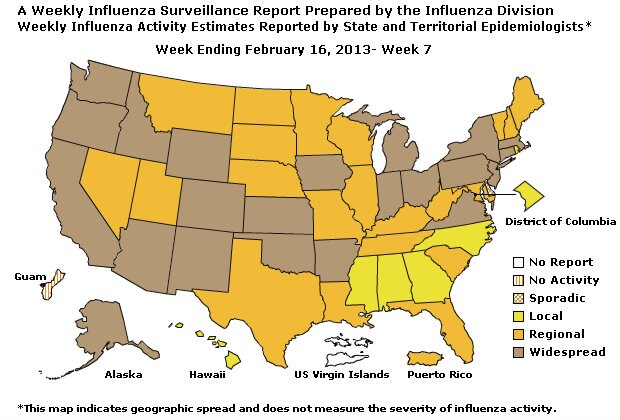
Flu Activity data in XML Format | View Full Screen
Additional National and International Influenza Surveillance Information
FluView Interactive: This season, FluView includes enhanced web-based interactive applications that can provide dynamic visuals of the influenza data collected and analyzed by CDC. These FluView Interactive applications allow people to create customized, visual interpretations of influenza data, as well as comparisons across flu seasons, regions, age groups and a variety of other demographics. To access these tools visit http://www.cy118119.com/flu/weekly/fluviewinteractive.htm.
U.S. State and local influenza surveillance: Click on a jurisdiction below to access the latest local influenza information.
Google Flu Trends: Google Flu Trends uses aggregated Google search data in a model created in collaboration with CDC to estimate influenza activity in the United States. For more information and activity estimates from the U.S. and worldwide, see http://www.google.org/flutrends/
World Health Organization: Additional influenza surveillance information from participating WHO member nations is available through FluNet and the Global Epidemiology Reports.
WHO Collaborating Centers for Influenza located in Australia, China, Japan, and the United Kingdom.
Europe: for the most recent influenza surveillance information from Europe, please see WHO/Europe at http://www.euroflu.org/index.php and visit the European Centre for Disease Prevention and Control at http://ecdc.europa.eu/en/publications/surveillance_reports/influenza/Pages/weekly_influenza_surveillance_overview.aspx
Public Health Agency of Canada: The most up-to-date influenza information from Canada is available at http://www.phac-aspc.gc.ca/fluwatch/
Health Protection Agency (United Kingdom): The most up-to-date influenza information from the United Kingdom is available at http://www.hpa.org.uk/Topics/InfectiousDiseases/InfectionsAZ/SeasonalInfluenza/
Any links provided to non-Federal organizations are provided solely as a service to our users. These links do not constitute an endorsement of these organizations or their programs by CDC or the Federal Government, and none should be inferred. CDC is not responsible for the content of the individual organization web pages found at these links.
--------------------------------------------------------------------------------
A description of surveillance methods is available at: http://www.cy118119.com/flu/weekly/overview.htm
